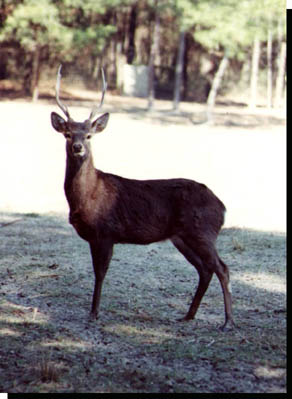
| Sika (Cervus nippon) is the Japanese name for deer. Sikas are known as small deer that pack a wallop and can be aggressive. The smallest sika are from Japan and Formosa and they become larger as you go north to the east coasts of China and Siberia. | 
|
| This young buck looks much like his bigger cousin, the red deer. |
| Most
people think of sikas as tiny deer, and much of the time they're right,
but sikas come in a huge range of sizes. The Dybowski sikas are the largest
with bucks that stand from 35 - 43" and weigh 150 - 240lb! The
does are 32" high with weights of 100 -110lb. Then there are the
dainty Japanese sika which are 30 -35" high weighing 100 - 176lb.
In Texas there has been much interbreeding among the free roaming exotics and so we have many hybrid forms, but before Texas the sika had been farmed extensively in their native lands where quite a bit of hybridization had already occurred even before export. The sika's color changes with the season and with their genetic type. Color ranges from a light ash brown to black in winter (you might or might not see traces of its spots), and in summer a red brown or a dark ash brown with distinct to faded spotting. A notable feature of sikas is the erectile hairs on their heart shaped rump patch. When the deer is alarmed the hairs form a striking large puff, and unlike our whitetail, they keep their tails firmly down. The bucks as well as does develop a set of tusks in the upper jaw, but they are not usually visible
In spite of the huge size difference, genetically the small sika are close to the huge American wapiti (elk) and the red deer ("European elk"). The similarity is seen in the heavy neck mane that they all develop in the rut, the antlers that sweep back with an upward curve, and their general look and posture. The hybrid of the sika doe and the American elk is called a "silk" deer. While the elk bugle, the red deer and the sika are said to roar. Some of the sounds of the sika buck, though, suit their much smaller size and sound less like a roar and more like a squealing hinge that whines downward in pitch. Sikas are particularly vocal deer, from newborns who set up a squall if you pick them up, to does that whistle alarm signals, to rutting bucks that will serenade the does for hours nonstop. Sika are forest dwellers and also do well in hilly and mountainous terrains. They are great adapters and this makes them successful as exotics. They adjust readily to availability of graze, browse, forbs and mast . The social groupings tend to be female groups. Fawns become independent early on and the yearling bucks go on into bachelor groups. As the rut nears, like his big cousin the red deer, a dominant buck will begin to cultivate his harem. Buck fights are often brutal with the primitive style fighting which is to injure rather than spar. The meat of the sika is excellent, and it has fat within the muscle giving it a juicy quality in contrast to the leanest game. Even so the cholesterol levels are much lower than beef and pork. |
|
SIKA 1 SIKA 2 SIKA 3 ANIMALS |